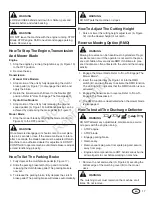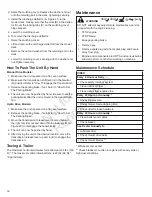
Not for
Reproduction
16
3. Make sure the Blade Control (A, Figure 6) is in the OFF
position.
4. Fully depress the Clutch/Brake Pedal (A, Figure 7).
5. Move the engine speed control (A, Figure 8) to the FAST
position (or CHOKE position, if equipped).
NOTE: The CHOKE position is not required when starting a
warm engine.
6. Insert the ignition key (A, Figure 9) into the ignition
switch. Turn the key to the START position until the
engine starts.
NOTE: When the ignition key is turned to START, the engine
will turn over, but will not start unless the Clutch/Brake pedal
is fully depressed and the Blade Control is in the OFF posi-
tion.
NOTE: If after 5 seconds of cranking the engine does not
start, release the key, make sure the Clutch/Brake Pedal is
fully depressed, and attempt starting again after waiting for
approximately 20 seconds.
7. After the engine starts, move the engine speed control to
the FAST position (if equipped with choke) and allow a
brief warm-up until engine runs smooth.
NOTE: Always operate with the engine speed control in the
FAST position.
NOTE: The headlight (featured on select models) is opera-
tional any time the ignition switch is in the RUN or START
position.
Recoil Start:
1. Manual Drive Models - Move the transmission shift lever
to the Neutral (‘N’) position. Refer to “How To Engage The
Transmission”.
WARNING
DO NOT start the engine with the transmission shift lever
in a drive position. Follow starting instructions carefully.
2. Make sure the Blade Control (A, Figure 6) is in the OFF
position.
3. Set the parking brake. Refer to “How To Set The Parking
Brake”.
4. Move the engine speed control (A, Figure 8) to the FAST
position (or CHOKE position, if equipped).
NOTE: The CHOKE position is not required when starting a
warm engine.
5. Insert the ignition key (A, Figure 10) into the ignition
switch. Turn the key to the RUN position (B).
6. Grasp the recoil start handle on the engine (A, Figure 11)
and pull briskly until the engine starts.
7. After the engine starts, move the engine speed control to
the FAST position (if equipped with choke) and allow a
brief warm-up period until engine runs smooth.
NOTE: Always operate with the engine speed control in the
FAST position.
NOTE: The headlight (featured on select models) is opera-
tional any time the ignition switch is in the RUN position.
How To Engage The Mower Blade
1. Start the engine.
2. Move the blade control (A, Figure 12) to the ON position.
How To Engage The Transmission
Manual Drive Models:
1. Start the engine.
2. To move forward:
• Depress the clutch/brake pedal (A, Figure 7).
• Move the transmission shift lever (A, Figure 13) from
the Neutral (‘N’) position (B) into the first forward speed
notch (C).
• Release the clutch/brake pedal to begin forward motion.
• During forward motion, the transmission shift lever may
be placed in any desired forward speed (D) without
depressing the clutch/brake pedal.
3. To move backward:
• Depress the clutch/brake pedal (A, Figure 7).
• Move the transmission shift lever (A, Figure 13) from the
Neutral (‘N’) position (B) into the reverse speed slot (E).
• During reverse motion, the transmission shift lever may
be placed in any desired reverse speed without depress-
ing the clutch/brake pedal.
Hydro Drive Models:
1. Start the engine.
2. Make sure the parking brake is released. Refer to “How
To Set The Parking Brake”.
3. To move forward:
• Slowly depress the forward ground speed pedal (A,
Figure 14) to begin forward motion. Increase ground
speed by further depressing the pedal.
4. To move backward:
• Slowly depress the reverse ground speed pedal (B,
Figure 14) to begin reverse motion. Increase ground
speed by further depressing the pedal.
NOTE: For best cutting results, choose a slow forward speed
with the engine speed control in the FAST position. This com-
bination will allow the mower blade to lift the grass while cut-
ting smoothly and evenly.
NOTICE
If the transmission is moved into reverse while the mower
blade is engaged, the engine will shut off. If mowing in
reverse is necessary, refer to “Reverse Mowing Option
(RMO)”.
Summary of Contents for Rider REX-300
Page 3: ...N o t f o r R e p r o d u c t i o n 3 en A 7 A 8 A 9 A B 10 A 11 A 12 A B C D E 13 A B 14 ...
Page 4: ...N o t f o r R e p r o d u c t i o n 4 A 15 A 16 A B 17 A 18 A B C 19 A B 20 ...
Page 5: ...N o t f o r R e p r o d u c t i o n 5 en A B C 21 A 24 A B 22 F B E C D G A 25 A B 23 ...
Page 6: ...N o t f o r R e p r o d u c t i o n 6 D A B C E A 26 A 29 A 27 A 30 B A 28 A 31 ...
Page 7: ...N o t f o r R e p r o d u c t i o n 7 en A C D E F B 32 A B C 33 ...
Page 25: ...N o t f o r R e p r o d u c t i o n 25 en ...
Page 43: ...N o t f o r R e p r o d u c t i o n 25 da ...
Page 61: ...N o t f o r R e p r o d u c t i o n 25 de ...
Page 79: ...N o t f o r R e p r o d u c t i o n 25 el ...
Page 97: ...N o t f o r R e p r o d u c t i o n 25 es ...
Page 115: ...N o t f o r R e p r o d u c t i o n 25 fi ...
Page 133: ...N o t f o r R e p r o d u c t i o n 25 fr ...
Page 151: ...N o t f o r R e p r o d u c t i o n 25 it ...
Page 169: ...N o t f o r R e p r o d u c t i o n 25 nl ...
Page 187: ...N o t f o r R e p r o d u c t i o n 25 no ...
Page 205: ...N o t f o r R e p r o d u c t i o n 25 pt ...
















































